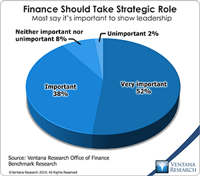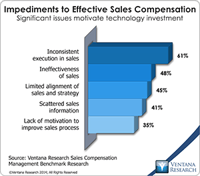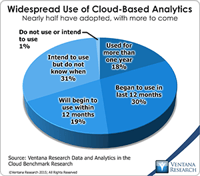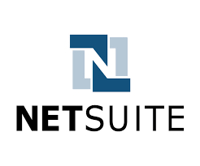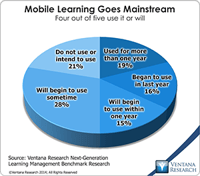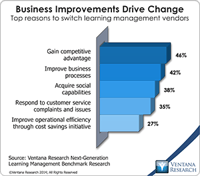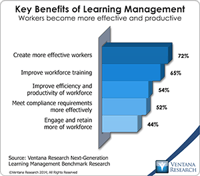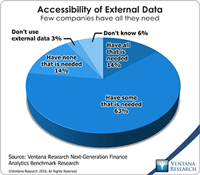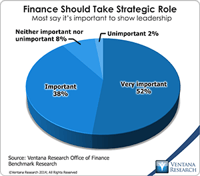Continuous planning is a term Ventana Research uses for a high participation, collaborative, action-oriented approach to planning built on frequent, short planning sprints. This enables organizations to enhance the accuracy of their plans because refinements are made at shorter intervals. Short planning cycles enable companies to achieve greater agility in responding to market or competitive changes. “Continuous” also means continuous across the entire organization – planning as an ongoing...
Read More
Topics:
Human Capital,
Business Collaboration,
finance,
Business
Like many other industry observers I’ve heard overblown claims for information technology for decades. However, I’ve also observed that – eventually – reality catches up with vision. Finance and accounting departments are particularly resistant to change, yet because almost no corporations use adding machines or typewriters any more, it’s clear that transformative change can happen. Nonetheless, because users of business computing systems are inundated with “it’s better than ever” promotions by...
Read More
Topics:
Social Media,
Supply Chain Performance,
Human Capital,
Mobile Technology,
Office of Finance,
Operational Performance,
Business Analytics,
Business Collaboration,
Business Intelligence,
Business Performance,
Cloud Computing,
Financial Performance
Imagine how the third Monday in next January looks to leaders in the sales department. That’s the first day of the annual sales kickoff and the excitement level won’t get any higher. New products and services are in the works, lucrative customer contracts are up for renewal, alliance partners are in the house, and qualified opportunities are already flowing through your pipeline. The executive team is expecting big things from sales in the new year and has approved hiring additional people to...
Read More
Topics:
Sales,
Sales Performance,
Human Capital,
Human Capital Management,
Mobile Technology,
CRO,
Analytics,
Business Analytics,
Business Collaboration,
Business Performance,
Financial Performance,
Operational Intelligence
Cloud-based computing has become widespread, particularly in line-of-business applications from vendors such as Salesforce and SuccessFactors. Our benchmark research also suggests a rise in the acceptance of cloud-based analytics. We’ve seen the emergence and growth of cloud-only analytics vendors such as Domo and GoodData as well as cloud-based delivery by nearly all the on-premises analytics vendors. Almost half (48%) of organizations in our benchmark research on data and analytics in the...
Read More
Topics:
Sales Performance,
Supply Chain Performance,
Human Capital,
Business Intelligence, Business Analytics, Cloud,,
Customer Performance,
Operational Performance,
Business Analytics,
Business Intelligence,
Business Performance,
Cloud Computing,
Financial Performance,
Information Management,
Uncategorized
It’s widely agreed that customer experience is now the most important dynamic for business. Any organization that wants to retain loyal and even vocal customers should do everything possible to ensure and maintain customer satisfaction. Software companies, especially those that promise to provide CRM and effective interactions across any channel at any time, should be good examples of embracing the methods they prescribe for using their products. But do they?
Read More
Topics:
Sales Performance,
Supply Chain Performance,
Human Capital,
Customer Performance,
Operational Performance,
Business Performance,
Cloud Computing,
Uncategorized,
NetSuite, TribeHR, HCM, HR, HRMS, Customer Experie
The learning management system (LMS) offers opportunity for organizations to progressively enhance the effectiveness of their workforce. An advanced LMS can be more than a digital version of an organization’s training programs for specific jobs or to achieve compliance with policies and regulations. It can provide dynamic yet informal learning that business units can create, deploy and sustain through their own efforts. Last year I outlined the benefits of this new generation of learning...
Read More
Topics:
Sales Performance,
Supply Chain Performance,
Human Capital,
LMS,
Customer Performance,
Operational Performance,
Business Analytics,
Business Collaboration,
Business Performance,
Cloud Computing,
Financial Performance,
Uncategorized
In this highly competitive age, optimizing the potential of workers is essential. A learning management system (LMS) can increase both knowledge and engagement. Our benchmark research on next-generation learning management systems finds that adopting one can help almost half (46%) of organizations gain a competitive advantage, and more than one-third (35%) said it assists in helping customers. Expanded use of learning can engage customers, partners and others who need more information about an...
Read More
Topics:
Human Capital,
Meridian, Learning, Learning Management Systems, L,
Customer Performance,
Operational Performance,
Business Performance,
Uncategorized
Businesses and their human resource organizations feel pressure to maximize the value of their human capital in today’s intensely competitive world. Many have made or considered investments in new applications that better exploit information to efficiently recruit, engage and retain the best talent. Advanced applications not only advance these processes but also help management assess the performance of the workforce and compensate individuals fairly so that they advance their careers and find...
Read More
Topics:
Big Data,
Predictive Analytics,
Governance,
HCM, HR, HRMS, Workforce Management, Learning Mana,
Human Capital,
Mobile Technology,
Wearable Computing,
Customer Performance,
Business Analytics,
Business Collaboration,
Business Performance,
Cloud Computing,
Financial Performance,
Governance, Risk & Compliance (GRC),
Information Management,
Uncategorized,
Financial Performance Management (FPM)
Using information technology to make data useful is as old as the Information Age. The difference today is that the volume and variety of available data has grown enormously. Big data gets almost all of the attention, but there’s also cryptic data. Both are difficult to harness using basic tools and require new technology to help organizations glean actionable information from the large and chaotic mass of data. “Big data” refers to extremely large data sets that may be analyzed computationally...
Read More
Topics:
Big Data,
Data Science,
Planning,
Predictive Analytics,
Sales Performance,
Social Media,
Supply Chain Performance,
FP&A,
Human Capital,
Marketing,
Office of Finance,
Operational Performance Management (OPM),
Budgeting,
Connotate,
cryptic,
equity research,
Finance Analytics,
Kofax,
Statistics,
Operational Performance,
Analytics,
Business Analytics,
Business Performance,
Financial Performance,
Business Performance Management (BPM),
Datawatch,
Financial Performance Management (FPM),
Kapow,
Sales Performance Management (SPM)
The imperative to transform the finance department to function in a more strategic, forward-looking and action-oriented fashion has been a consistent theme of practitioners, consultants and business journalists for two decades. In all that time, however, most finance and accounting departments have not changed much. In our benchmark research on the Office of Finance, nine out of 10 participants said that it’s important or very important for finance departments to take a strategic role in...
Read More
Topics:
Big Data,
Planning,
Predictive Analytics,
Social Media,
Governance,
GRC,
Human Capital,
Mobile Technology,
Office of Finance,
Budgeting,
close,
Continuous Accounting,
Continuous Planning,
end-to-end,
Tax,
Tax-Datawarehouse,
Analytics,
Business Analytics,
Business Collaboration,
Business Performance,
CIO,
Cloud Computing,
Financial Performance,
In-memory,
Uncategorized,
CFO,
CPQ,
Risk,
CEO,
Financial Performance Management,
FPM

